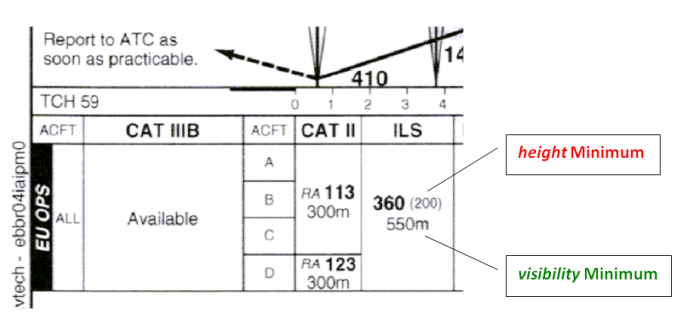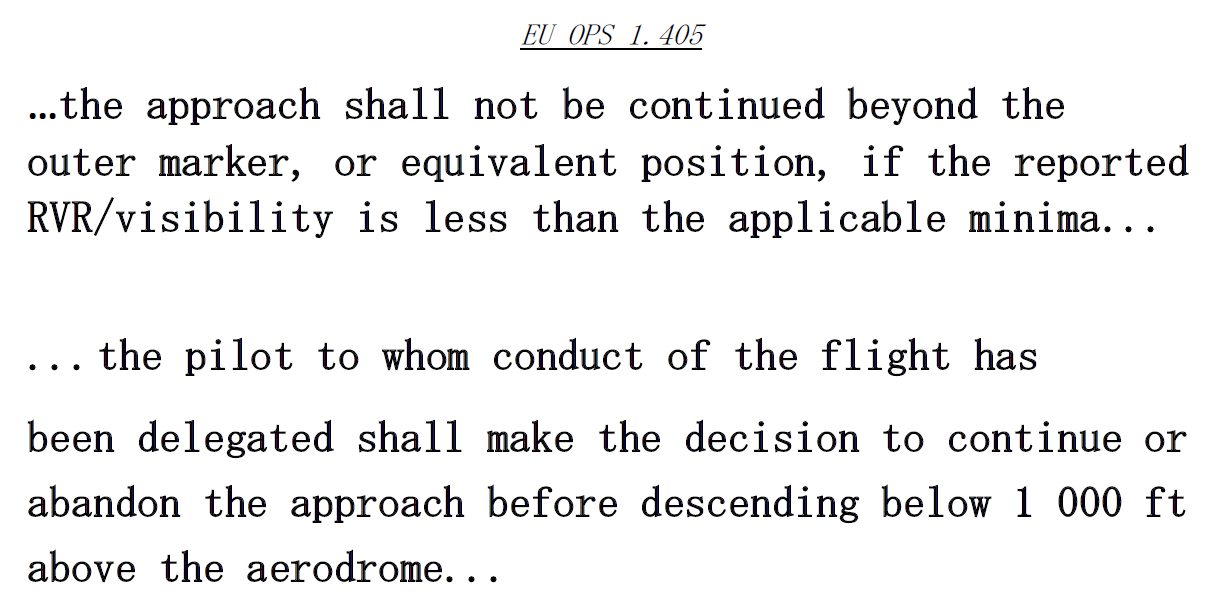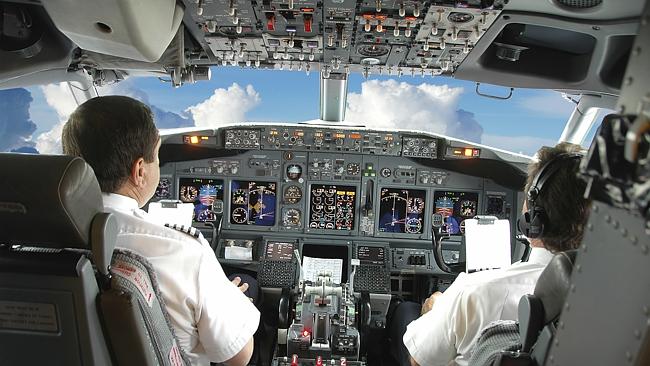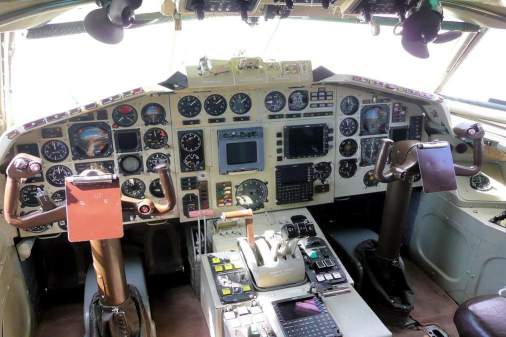
|
Full version In
short
|
Polski English
|
Summary
"...the
commander or the pilot to whom conduct of the flight has |



The Visibility Minimum is applied first - at decision (2), at a height which is safe even when the position of the aircraft is uncertain: never lower than 1,000 feet (300 metres) above the airport (legal regulation EU-OPS 1.405: "Commencement and continuation of approach"). If the actual visibility, supplied by Air Traffic Control is adequate, the pilot can continue the approach. If not, then he/she can do anything (wait, try a different runway, etc.) on condition that a height of 300 metres above the airport is maintained.
In the example shown above, if an ILS approach is being flown, the pilot can continue the approach below a height of 300 m only if the reported visibility is at least 550 metres.
In summary: the pilot can descend below 300 metres on the strict condition, that the visibility reported to him/her is sufficient.
The Height Minimum is applied at decision (3), therefore lower and later than the visibility minimum. The Height Minimum is what is known as the Decision Height to which the pilot descends - but only with the aircrafts position accurately controlled, and from where there is a chance of seeing the approach lights. On a precision approach, at the moment decision height is reached, if the runway is not visible, the pilot must immediately return to a safe height (execure a "Go-around").
In the example shown above, the Decision Height is 200 feet above the runway (or 360 feet above sea level).
In summary: in this example, the pilot can descend below 200 feet (about 75 metres) on condition that the runway is visible.
Why are two different places and heights used for the two decisions: (2) and (3)?
Because it makes no sense to descend to "Decision Height" if the visibility is so bad, that there is little chance of seeing the runway. Indeed, it is asking for disaster because that height does not guarantee that the aircraft will avoid a collision with even a small deviation from the correct approach path. The Decision Height is often lower than nearby buildings or hills. The slightest navigational error can be fatal. For some approaches, the Decision Height is zero feet (blind landing) - it is obvious, that flying around at that height "looking for the runway" is suicidal. In the EU (and therefore also in Poland) such "looking for the runway" when the visibility is too low is legally banned precisely to eliminate such temptations.
On what grounds is decision nr (2) required under polish law?
On the grounds of the ministerial decree on the subject of aviation safety dated 5th November 2004: "Rozporządzenia Ministra Infrastruktury z dnia 5 listopada 2004r w sprawie bezpieczenstwa ekspoatacji statków powietrznych (Dz.U.04.262.2609)". A copy of this document is available on the Polish Government website (links sometimes change):
| DESCRIPTION | Download from the Government website | Download local copy |
| Ministerial decree | Click here | Click here |
Go to page 4.
What is the exact wording of the EU-OPS 1.405 regulation ("Commencement and continuation of approach")?
You can find it on the European Union website:
| DESCRIPTION | LANGUAGE | Download from the E.U. website | Download local copy |
| Regulation EU-OPS 1.405 | English | Click here | Click here |
| Regulation EU-OPS 1.405 | Polish | Click here | Click here |
Relevant extracts:
 |
These are very technical matters. How can I confirm that this regulation really exists and is relevant?
Check out the above documents and ask someone who knows about commercial aviation.
Is this regulation legally binding always and everywhere?
All aircraft flying within the European Union and all EU carriers must legally always adhere to it.
This regulation originates from the International Civil Aviation
Organisation (ICAO) Standards and Recommendations. You can find it in the following
document: ICAO Annex 6 Part 1 Article 4.4.1.2. The ICAO is a United Nations
specialised agency.
Click here to
download a copy of the relevant page.
Do instructions from Air Traffic Control have the authority to override these regulations?
No. These regulations explicitly apply to pilots and no controller has the right to override them.
So what role does Air Traffic Control play?
Precisely the role that its name suggests: it controls the air traffic but does not control the aircraft. Additionally, controllers provide information (for example about the weather). Its role does not extend any further.
What happened in Smolensk on the 10-th of April?
Why did the pilots not apply decision nr (2)?
Because they applied the military regulation RL-2006, which, according to the "MIller Report", contains instructions that "raise doubts about their interpretation" and are "equivocal" in these matters (decision about continuation of approach and landing) (pages. 98 and 99).
It is worth adding, that the RL-2006 regulations themselves mandate that military flights apply civilian regulations in matters not covered by RL-2006 (§ 1 ust 4). In this document, the relevant paragraph (§ 19 ust 23 p 5) does not precisely define the "conditions of flight" on which approach continuation should be decided - from which one concludes that the civilian criteria in EU-OPS 1.405 should be used.
Is it not the case that military controllers have absolute authority over the actions of pilots?
Maybe in a given air force, yes, but certainly (since the dissolution of the Warsaw Pact) Russian military controllers have no such authority over Polish pilots.
Do military aircraft have to comply with these regulations (EU-OPS 1.405) at all?
If they are flying in battle, no - but when they are transporting people in conditions of peace: the reader can judge for himself/herself.
Were the pilots of the 36-th Special Air Transport Regiment familiar with the EU-OPS 1.405 regulation (and therefore with Polish and EU law)?
They had to be familiar because they flew to European airports, among them to Warsaw, where breaking these regulations is tantamount to breaking the law. They must have been familiar with the type of approach and landing instructions similar to the example shown above.
If the pilots had adhered to these Polish regulations (among them EUOPS 1.405) is there any possibility of this crash occurring?
This is a question that every reader should ask himself/herself and then should answer it.
Why did neither the "MAK" (Russian) report nor the "Miller" (Polish) report mention EU-OPS 1.405?
The authors of these reports should answer that question.
Since none of the official reports, books or articles mention this regulation, maybe it is not in reality applied or relevant?
Every flight crew of every airliner carries approach and landing instructions of the type shown above - which (in Europe) include a section on EU-OPS (or the equivalent PANS-OPS or JAR-OPS).

Pilots have direct access to landing instructions
that among others specify the approach limits

A typical airliner cockpit with the "approach plates" visible on the control columns

The cockpit of a Polish Tupolev 154M.
The approach plates, which normally include the EU OPS 1.405 limits,
are attached to the control columns
How does all this relate to the "conspiracy theories"?
The conspiracy theories have two main sources and "fuels":
It is very difficult to provide arguments in the first case. In the second case - the facts presented here (which anyone is capable of understanding and which can be easily and independently verified) show that this crash can be explained in the most simple and classical terms.
So why do so many Polish people entertain the possibility of an assassination?
Among others because neither the organisations tasked with explaining the crash, nor the media have taken these easily verifiable facts into account and presented them to the public.
Should one rule out an attack or sabotage?
Of course one should not rule out an attack or sabotage - but in view of the fact, that all the evidence points to an elementary accident, for the prevention of which there is a specific and unequivocal law - to prove a malicious cause one has to, among others, explain how the existing evidence for an accident is invalid.
How can we be sure that the pilots really did not apply decision nr (2)? Maybe they were duped by the controllers and made a correct decision based on false information about the visibility?
There are several sources, among them living Polish witnesses, confirming that the pilots knew that the actual visibility was 400 metres (whereas the required minimum was 1,200). This same information was conveyed to them four times, among others by Poles.
But "scientists have proven" that there were explosions, that traces of explosives were found, that a wing would slice through a tree trunk? Surely, there is a lot of "circumstantial evidence" indicating incompetence (by the investigating authorities), withholding of information, etc.?
Up to now, no credible evidence exists supporting these assertions but that is not the subject of this document. Putting all other aspects aside, the whole discussion about the above assertions centres on the suggestion that "The Tupolev had every right to descend to 100 metres". First and foremost, one has to state very clearly: The Tupolev had no right to descend to 100 metres, they had a right to descend to 300 metres. One then has to accept all the consequences of this fact - which will save many nonsensical arguments but which above all will provide the families and the whole nation a real and believable explanation of the tragic events that occurred on that day.
From that position, we will, as Poles, have a hope of releasing ourselves from the current spiral.
Download a copy of this document in PDF format (for example to print it)
Download a diagramatic document explaining the law in PDF format
Download "Jan's Report" in PDF format
(C) 2012-2016 Jan Chmielewski, all rights reserved.